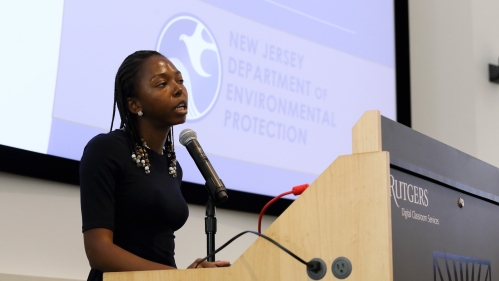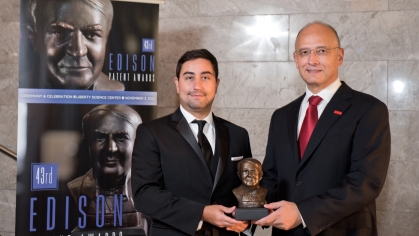Symposium Addresses Climate Change in Urban Environments

A recent symposium organized by Rutgers School of Engineering (SoE) and School of Environmental and Biological Sciences (SEBS) helped raise awareness and “broaden the dialogue” about policy and research on climate change in urban environments as leaders from industry, government, academe and environmental justice convened to explore ways to collaborate and innovate.
“Urban environments are home to billions of people around the world. We need broad engagement and effort to address environmental pollution and aging infrastructure for healthier and more resilient communities,” said Nenad Gucunski, professor and chair of the Department of Civil and Environmental Engineering.
The event also gave attendees a chance to learn and showcase work done in Rutgers’ labs, including research on high-efficiency growing technologies for urban farms, the detoxification of urban waterways, coastal sediment projects and hurricane reconnaissance and analysis. A student project to connect Rutgers 180-acre botanical gardens to the rest of campus also was featured.
“The university is a great incubator for innovation,” said SoE alumnus Malcolm McLaren, of the McLaren Engineering Group. “When I walk through these labs I get excited...We want to figure out how we can collaborate more.”
The effects of climate change are more severe in New Jersey than elsewhere, according to a 2020 report by the state Department of Environmental Protection (DEP) presented at the event, which drew more than 60 people.
“I can think of no better place to have a symposium like this,” said School of Engineering dean Thomas Farris, citing Rutgers work with partner industries. In addition to SoE and SEBS, the university’s Bloustein School of Public Policy and Planning also presented research at the symposium, sponsored by the large engineering firms of Langan and AECOM.
Partnerships and Progress
Academic partnerships are key in making progress on some of the thorniest environmental problems, and the time for action is now, said Katrina Angarone, associate commissioner for science and policy at the state DEP.
“We can’t argue about how high the sea is going to rise, it’s rising. We can’t wait for perfect data, it will be too late,” she said. Even smaller steps forward need to be “embraced and celebrated,” she said. “Big, bold change is fantastic, but let’s face it – it’s rare. Incremental change is important.”
The DEP report showed temperatures and sea levels rising: more intense storms and coastal flooding are imminent, and it’s extremely likely that Atlantic City will be flooded more than a quarter of the time by 2050. Add in poor air-quality, inland flooding and a lack of open space and it’s safe to say that New Jersey and its infrastructure are environmentally stressed.
The good news is the state is set to receive $13.5 billion in funding from the recently passed federal infrastructure bill for transit, climate, roads, bridges and other clean initiatives, officials said. As the symposium convened on May 20, the federal Environmental Protection Agency also announced $221 million in low-interest loans were being made available for 28 water infrastructure projects in New Jersey.
The state has set big goals for purchasing electric vehicles in the next several decades, officials said. And representatives from FEMA and NJ Transit spoke about planning for resiliency in coastal and low-lying areas (and both agencies said they need to hire more engineers).
Other speakers focused on creating healthier building materials and mitigating contaminated “brownfields” for sustainable development. And there was discussion on alleviating urban flooding – through innovations such as those that uncover and restore (“daylight”) streams and wetlands buried by development.
A Leader in Environmental Justice
A good portion of the symposium focused on the importance of environmental justice and community resilience, as regions and neighborhoods with the fewest resources often suffer the greatest impacts from climate change.
A recent law and executive order signed by NJ governor Phil Murphy makes the state a leader in attempting to protect so called “overburdened communities” from more environmental damage, said Kandyce Perry, director of the DEP’s Office of Environmental Justice.
“It’s a huge paradigm shift, we’re really excited for New Jersey to lead the way,’ Perry said in the afternoon keynote address. The new protections will come into play during the permitting process for industries or developments that seek to locate in communities that may already be environmentally stressed, she said, and efforts will be made to promote environmental justice throughout state agencies.
“It’s often overlooked how much planning and engineering is needed to see outcomes come to life in environmental justice,” said Jane Cohen, the executive director of Governor Murphy’s Office of Climate Change and the Green Economy.
Community advocates Carolina Ramos and Nicole Miller discussed their environmental justice work in Jersey City and Newark, respectively. Miller said community buy-in can take a generation so “robust incentives” were needed to spark involvement in the imminent fight against environmental degradation.
Panelists during an afternoon discussion agreed that more environmental education is needed beginning in elementary school. And they lauded academic partnerships, such as Rutgers Cooperative Extension, in bringing that education into communities.
All agreed time is of the essence. Cohen said the state is not on pace to meet its goal of reducing greenhouse gas emissions by 80 percent by 2030. “We have a lot of work to do,” she said. “We can’t put this off, we have to be focusing on our strategies now.”


